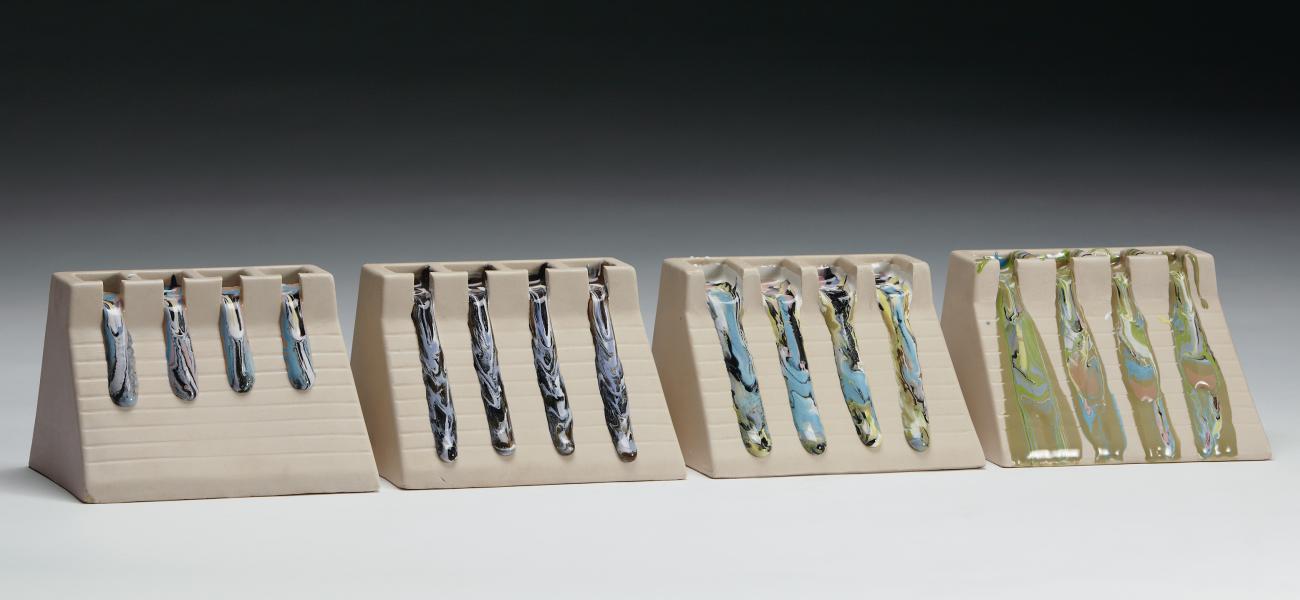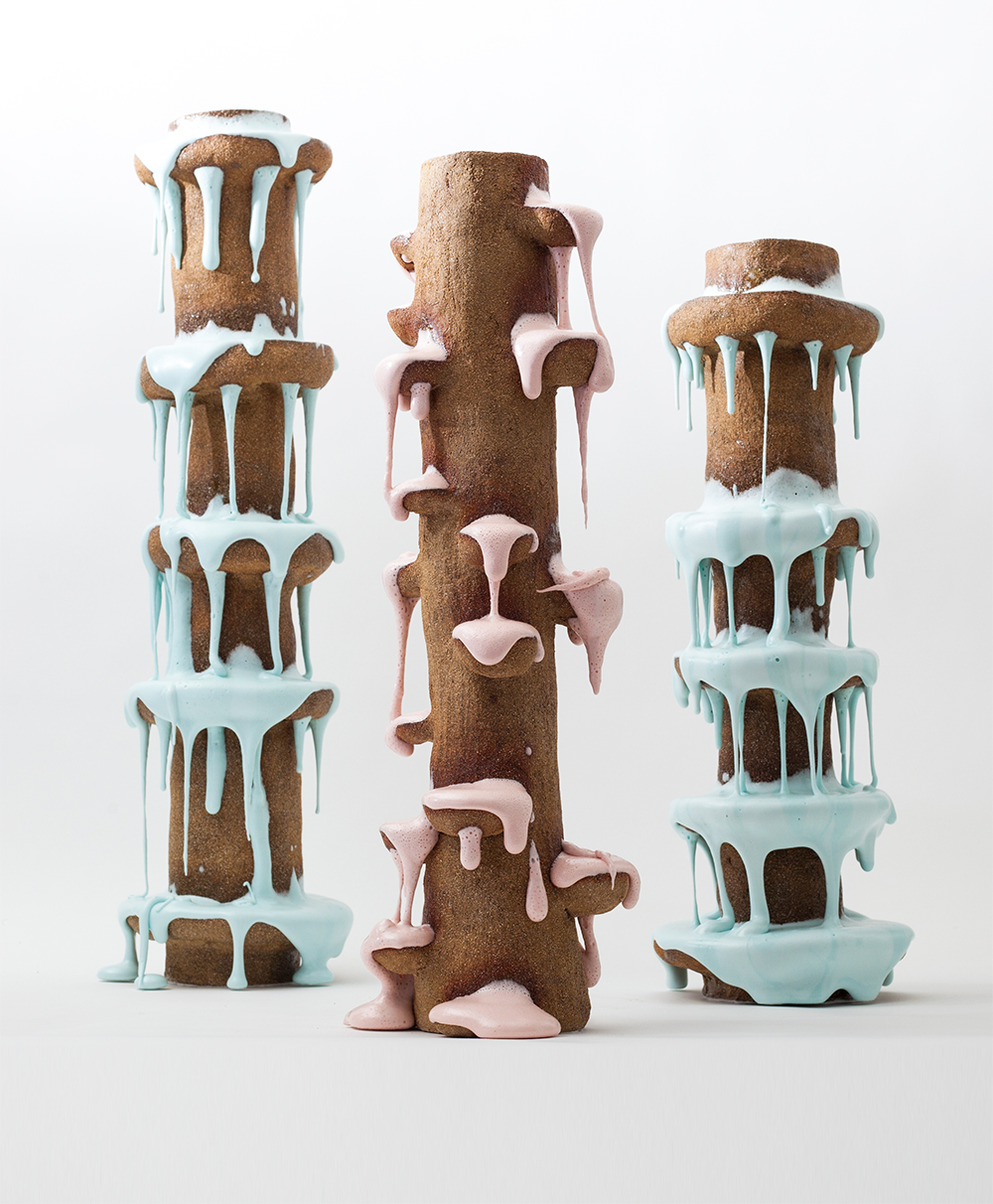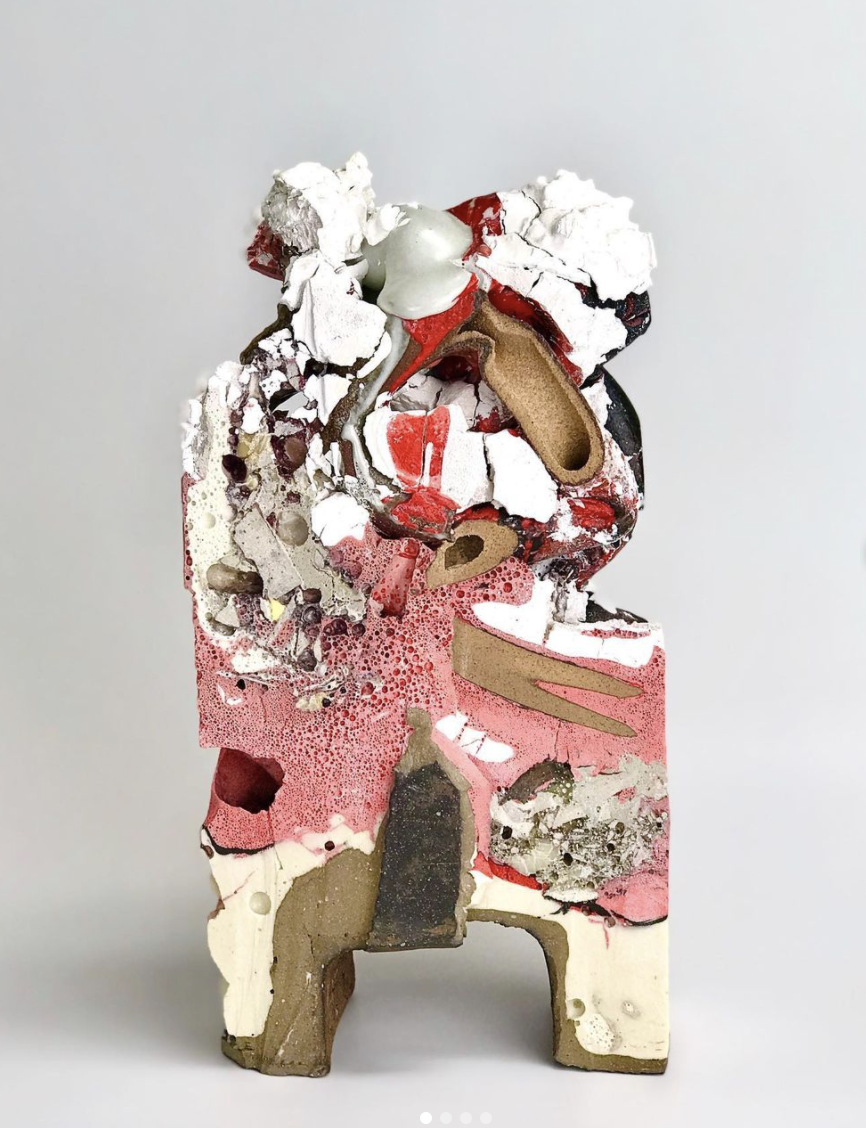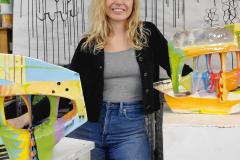The Context of Technique
 Sometimes I come upon something that feels special and I want to keep it as secret inspiration – like a love note written just for me. This happened when I discovered the work of Karen Thuesen Massaro at John Michael Kohler Arts Center (JMKAC), who used the Arts in Industry program to engineer a new way of working with glaze and clay.
Sometimes I come upon something that feels special and I want to keep it as secret inspiration – like a love note written just for me. This happened when I discovered the work of Karen Thuesen Massaro at John Michael Kohler Arts Center (JMKAC), who used the Arts in Industry program to engineer a new way of working with glaze and clay.
A Question of Origins
“Gloop” has legitimately become a new categorical glaze type along with celadons, copper reds, crystallines, and crawls. We now have ultra-thick, viscous, stretchy masses of fused ceramic materials that exist somewhere between liquid and solid states. I would include myself in a rapidly growing group of makers who are enamored with the characteristics of glazes that fit this description. The preeminent makers of the 2010s working in this style are being imitated in the current decade by masses of curious artists who access the aesthetic in real-time on various social media outlets. Since the internet blurs our ability to decipher the origins of new trends some have voiced proprietary concerns regarding artistic plagiarism and I can muster some empathy on this account – imitation is not always flattery. But when I question the origins of the experimental glaze movement I wonder: should artists who dabble in voguish glazes be disparaged?
The context in which technique is applied turns good work into great work. If ceramics expects to enjoy its growing status in the art world, we should celebrate artists who intentionally hone their technique to contextualize their concepts rather than categorize and dismiss them based on what glazes they use. Furthermore, we should not let any one voice dictate what aesthetics are off limits because they believe a particular artist has already laid claim to the territory. When one perspective spreads online it dominates and important nuances are lost in the fracas. I’m most concerned with the glaring absence of women’s names in discussions of the abstract glaze aesthetic. There is also a lack of consideration for any practice that engaged materiality and flow before the year 2000 (both inside and outside of the ceramic world). The newest, most extreme abstract glazing styles prevalent today, have roots in modernism. Finally, there is an overall lack of depth in these origin discussions. The focus seems to stay at one level, never spilling over to consider the nuanced variety of how extreme glazes are being used today
Our propensity in ceramics for talking shop allows us to hide behind technique and avoid the real work of understanding the contextual space we find our work occupying. Although I believe most artists find their voices through an intuitive process, it is important to eventually contextualize what you are making. Acknowledge whose shoulders you stand upon.
The quasi-sexual allure of dripping glazes is almost as old as ceramics itself. Some of my favorite juicy glazes are on Chinese Tang Dynasty sancai (tri-color) pieces from the seventh-century. The colors flow into one another with wild abandon, running from head to toe on pots and sculpture alike. These artists did not have frits, mason stains, or the luxury of importing the perfect feldspar for the job. (If they had, wouldn't you have liked to have seen what they would have made?) Although our material vocabulary has expanded a lot since the seventh century, we face a similar dilemma of aesthetic homogeneity. Twenty-first century artists have access to, not only the same materials, but also mainstream open-source formulas. Naturally, there will be overlapping results. Objects may look familiar even when the research and concepts are individuated.
A Moment of Inspiration
About an hour-long drive from Milwaukee, the galleries at JMKAC in Sheboygan, Wisconsin, were gently buzzing with weary conference attendees at the end of a long week. The 2014 National Council on Education in the Ceramic Arts had just concluded. Despite being at maximum saturation, I found myself awestruck and absorbed, drawn across the room by smallish pyramid-shaped gems – the brilliance of Glaze Flow Blocks by Massaro had me gripped.
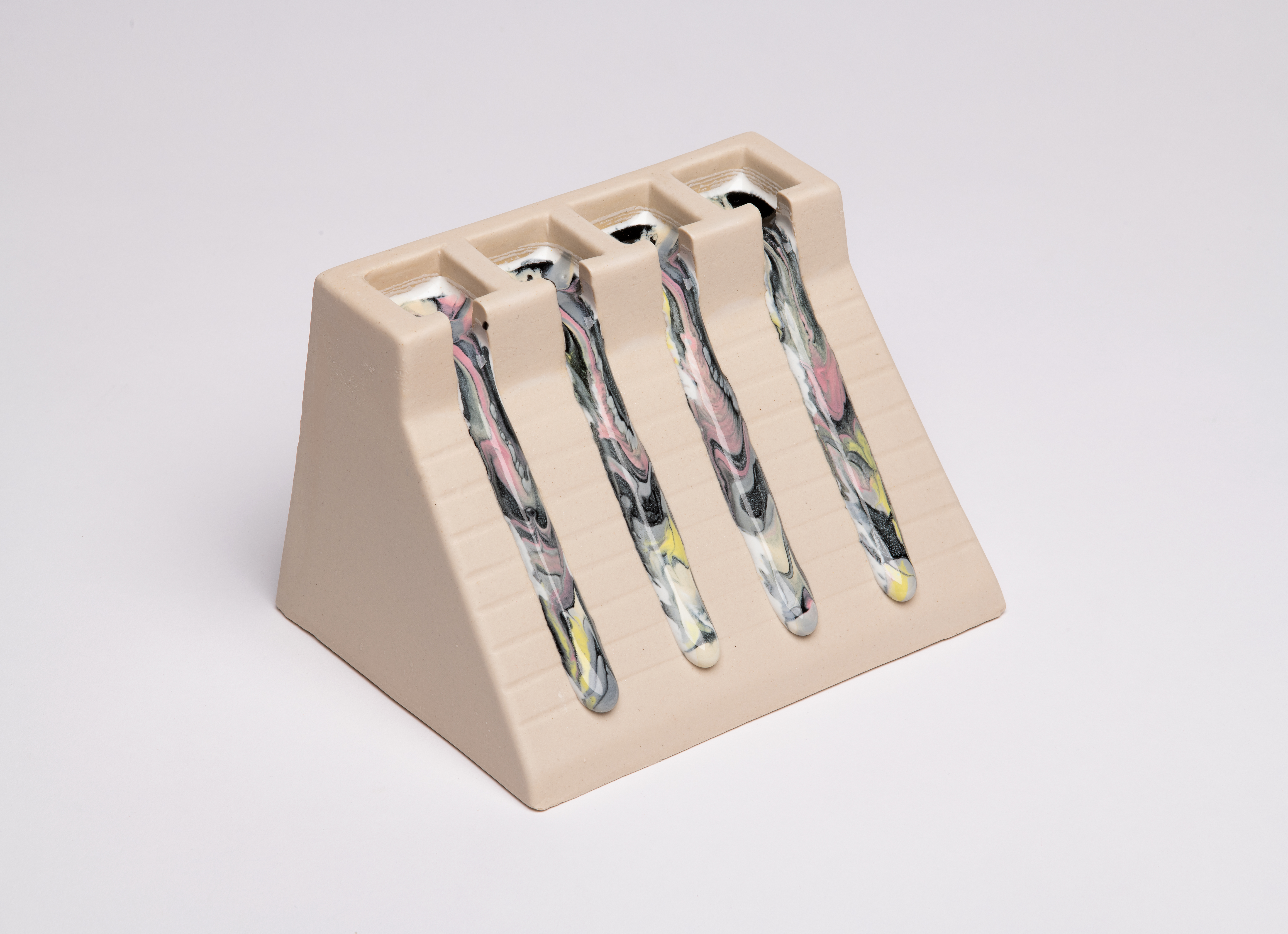 In an archetypal sense, the series evoked abstract Aztec temples devoted to the gods of eutectics. Glossy, viscous glaze oozed out of little reservoirs at the peak of each pyramid, conjuring sacrificial worship. Gooey rivers of glaze trailed down the pyramids, as if in competition with one another, to see which might reach the base of the pyramid first. The didactic material accompanying the sculpture indicated that during her 1976 residency, "Massaro was the first artist to use the factory's auxiliary objects and processes to make art."
In an archetypal sense, the series evoked abstract Aztec temples devoted to the gods of eutectics. Glossy, viscous glaze oozed out of little reservoirs at the peak of each pyramid, conjuring sacrificial worship. Gooey rivers of glaze trailed down the pyramids, as if in competition with one another, to see which might reach the base of the pyramid first. The didactic material accompanying the sculpture indicated that during her 1976 residency, "Massaro was the first artist to use the factory's auxiliary objects and processes to make art."
These forms, called ‘flow blocks,’ are a common tool in ceramic manufacturing, used to measure glaze viscosity. The work exuded scientific energy: at once a simple observation of time, temperature, and the phenomena of glaze. These works were asking me to consider the order of her process. I had to stop and think: How did this happen? What roles did heat and gravity play in this equation? There was a literal sense of measurement in the work. It was simple, yet psychedelic and playful.
The basic idea of “Gloop” was right there in its infancy: lively, dimensional, and dripping with understanding. All twenty-first century glaze-crazed artists are preceded by this work – work Masaro did in the 1970s.
An Act of Recognition
Because the work impacted me so strongly, because of the work I make, and because her name, among others, was absent from the social media debate about the foundations of this aesthetic – I want to share where I saw it first. I need to publicly trace my route back to this body of work, sharing my inspiration for molten glaze work. There needs to be a counter narrative.
Massaro was gracious enough to Zoom with me and tell me about her career experiences. She was born in Copenhagen, Denmark, in 1944. She immigrated to the United States as a child with her parents. Her father was a furniture maker, so craft was a part of her life from a young age. Massaro told me about each of her trips to Kohler and how she interacted with the industrial environment. Originally she was invited as an assistant to Jack Earl while also making her own work and taking part in the exhibition Plastic Earth.
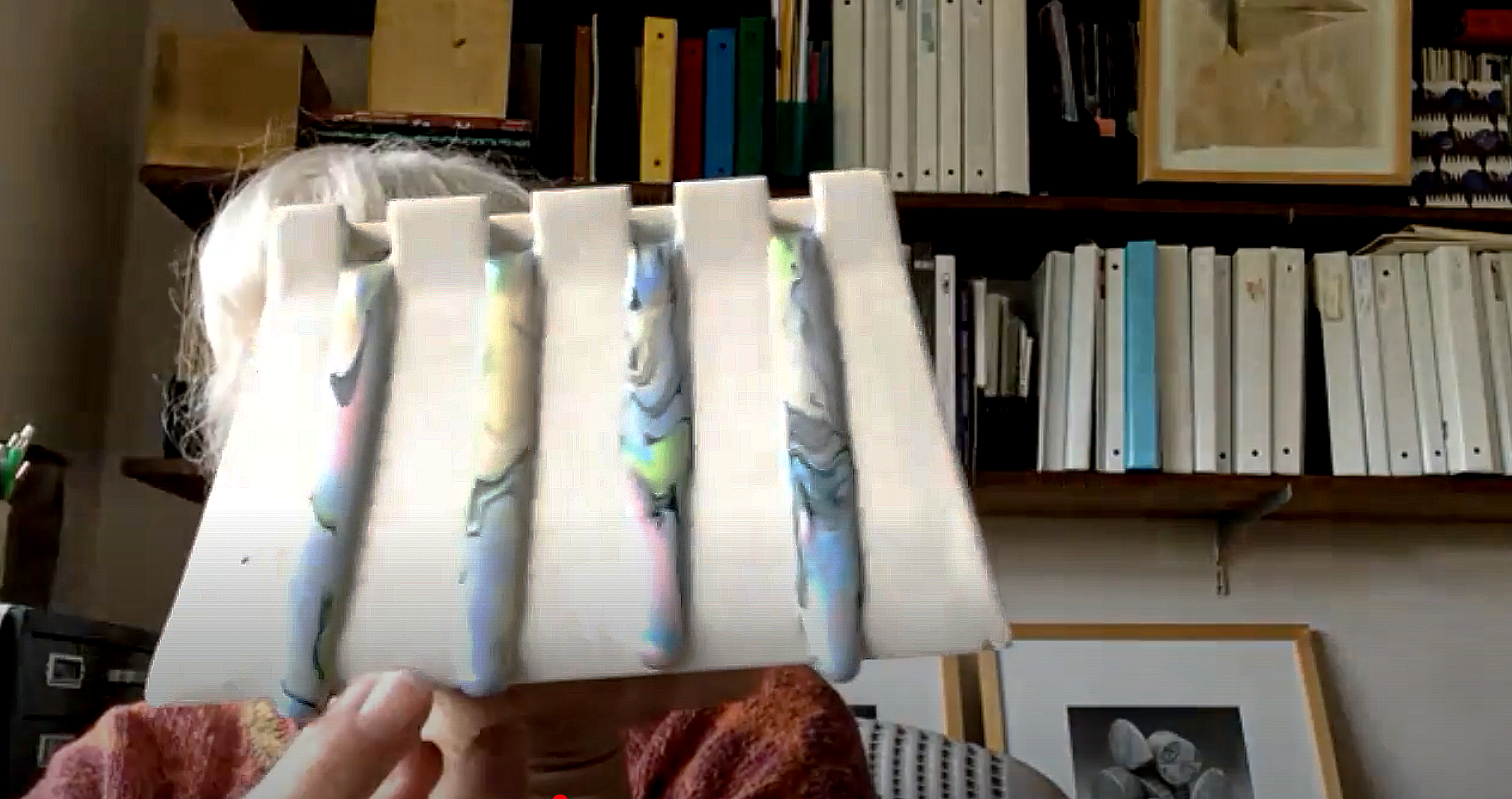
There were multiple visits to Kohler between 1973 and 1979. Massaro quickly moved from altering plumbing ware, picked from the production line, to exploring mold making and marbling colored slips. It was the experience of marbling buff and black-colored casting slips in a mold that later emerged in her work with glazes.
“Maybe it was graduate school at the University of Wisconsin, Madison, or maybe it was just the zeitgeist at the time, but Duchamp’s work was influential on many of us.” She commandeered the glaze blocks. Massaro remembers: “I would watch them go on the carriers, through the kiln, and then it struck me that I could apply glaze over that and I would have an interesting situation in the sense that what I was doing was actually parallel to what originally happened.” Putting her glaze over theirs, it would ride through the kiln again and produce a new recording of the heat situation. On the back of the blocks, the factory marked the firing date. Below their markings, Masarro added her own dates. Six years after I saw this work for the first time, I learned the marbled glazes are essentially a veneer – a provocative and masterful illusion.
Massaro loved color and glaze from the beginning. In her own words she, “uses ceramics, an integration of form and surface in space, to pose questions about placement, movement, and perception.” Much of her work explores abstracting everyday objects through layers of removal from reality. She is known for her work that abstracts objects – ranging from functional forms to plastic dog toys, changing the surface or aspects of the form, or both. “Some of those [earlier] ideas wound their way into glaze paintings.”
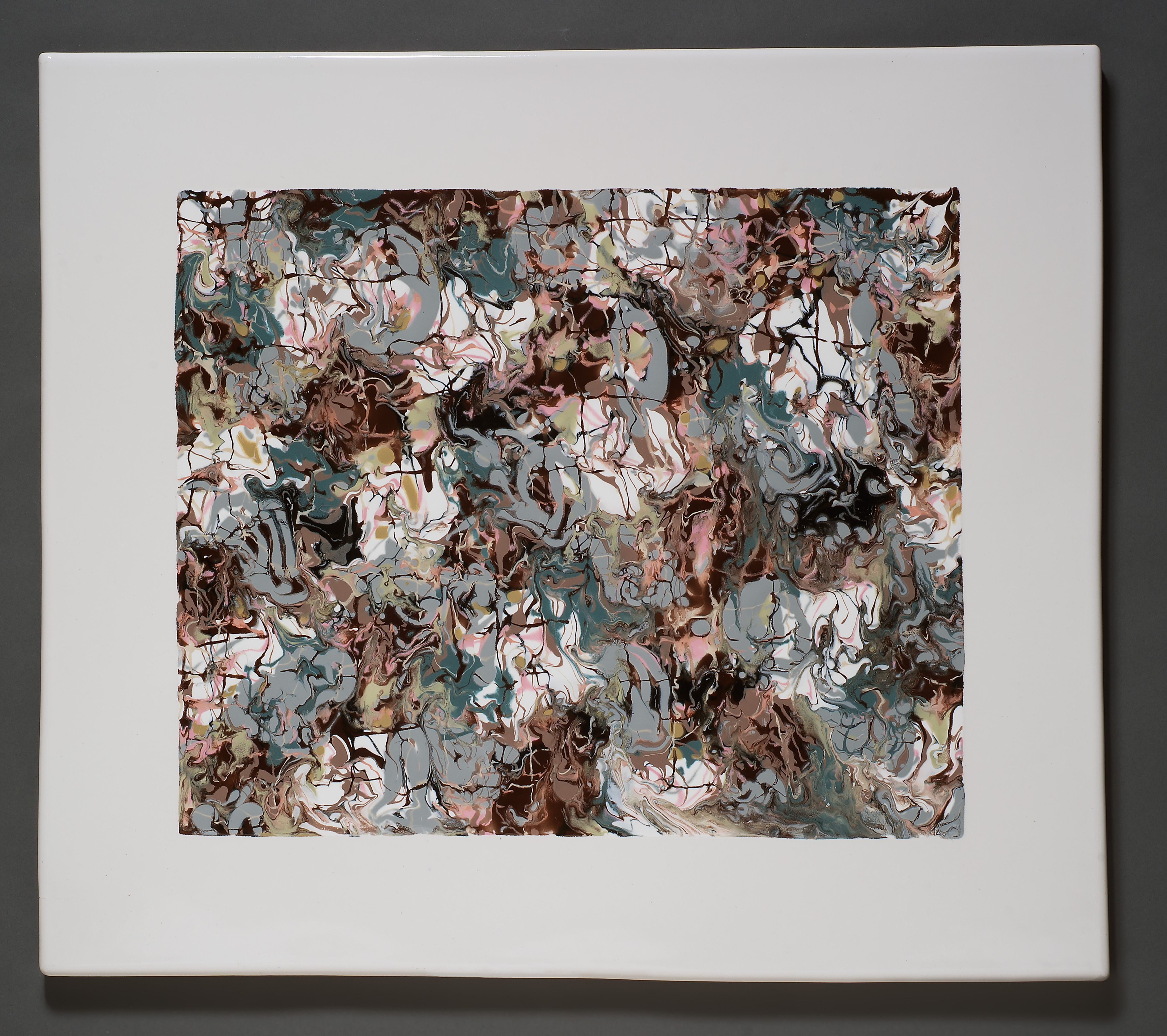 Although the series of flow blocks was an extension of the readymade, Massaro’s glaze paintings took on a different meaning. Perfectly white and flat, the oversized porcelain canvases Massaro worked on averaged 19 x 22 inches each. “I chose the larger format so you would be totally enveloped in glaze.” Masarro recalled the phenomenal glazes at Kohler; “You can have a black and white [glaze] right next to each other and they don't bleed together”.
Although the series of flow blocks was an extension of the readymade, Massaro’s glaze paintings took on a different meaning. Perfectly white and flat, the oversized porcelain canvases Massaro worked on averaged 19 x 22 inches each. “I chose the larger format so you would be totally enveloped in glaze.” Masarro recalled the phenomenal glazes at Kohler; “You can have a black and white [glaze] right next to each other and they don't bleed together”.
Similar to
how many things at Kohler are produced, the wares and tiles are fired to cone ten first. Then glazes are applied to the vitreous porcelain and down fired to cone 04. The way Massaro worked on top of the vitreous surface is partly what allowed the glazes to pass over and under one another as fluidly as watercolor might.
“I think ceramic color richness and variation compares with that of flowers, glass, rocks, air, and the sky – and now sometimes also with computer generated color. There is such potential in varied glaze luminosity and real and implied depth. Maybe eventually our field will change, and these phenomena will no longer be of primary interest. That's possible, but it won't be for me or in my lifetime.”
For many, the glaze paintings might have been seen as a move intending to subvert the hierarchy of painting and craft – a debate that raged among her peers in the 1970s, but for Massaro there was no difference. For her, functional cups and installation art all serve in equal roles.
Permeable Boundaries
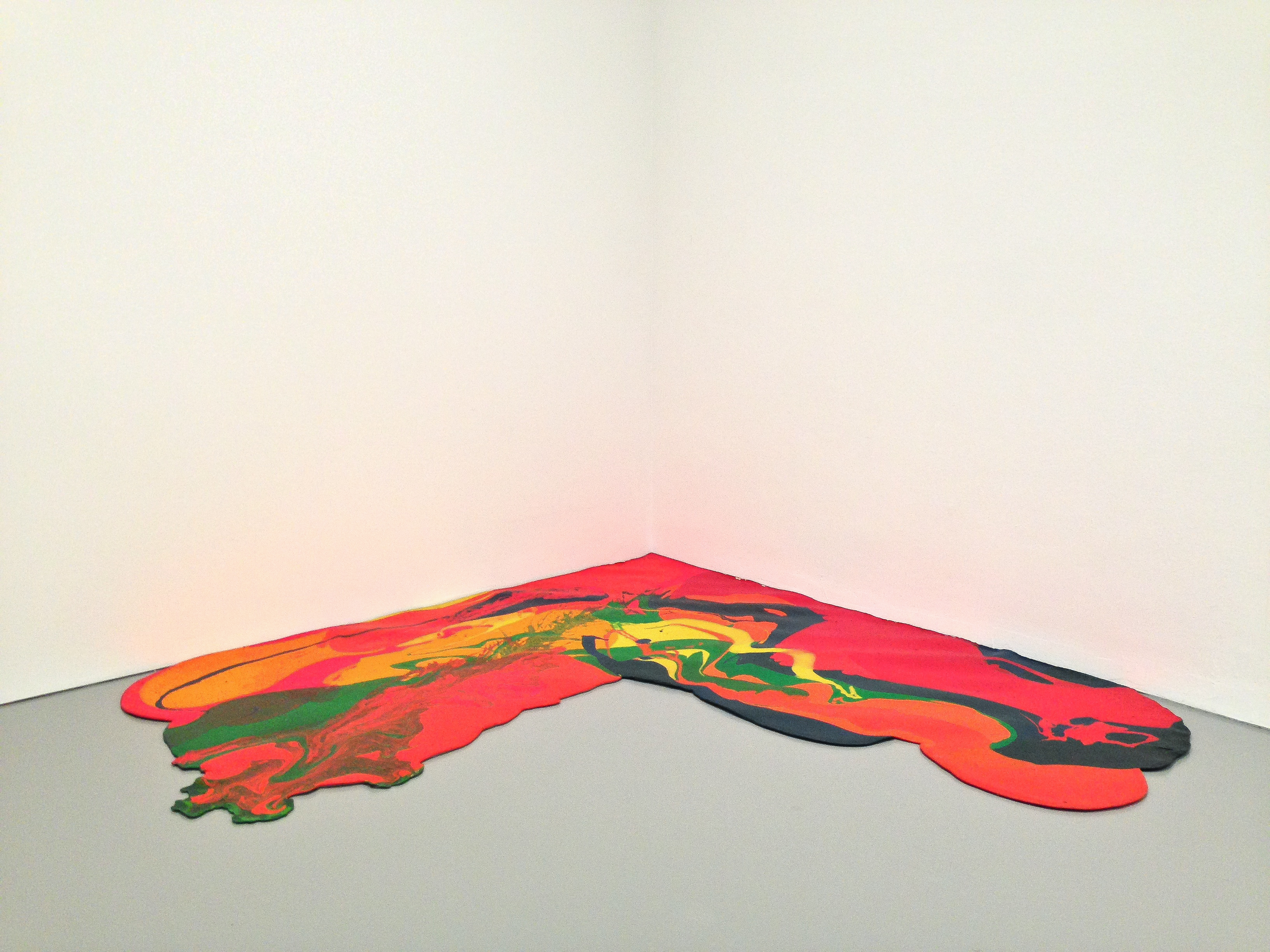
Ceramics seems to need luscious tidal waves of glaze more than ever right now, but we should look beyond these materials as our only inspiration. Arguably the aqueous, flowing, ‘blobject’ aesthetic also belongs to artists like Lynda Benglis (American, b. 1941) and other feminist artists who were responding to the hard-edged masculine sculpture of the sixties.
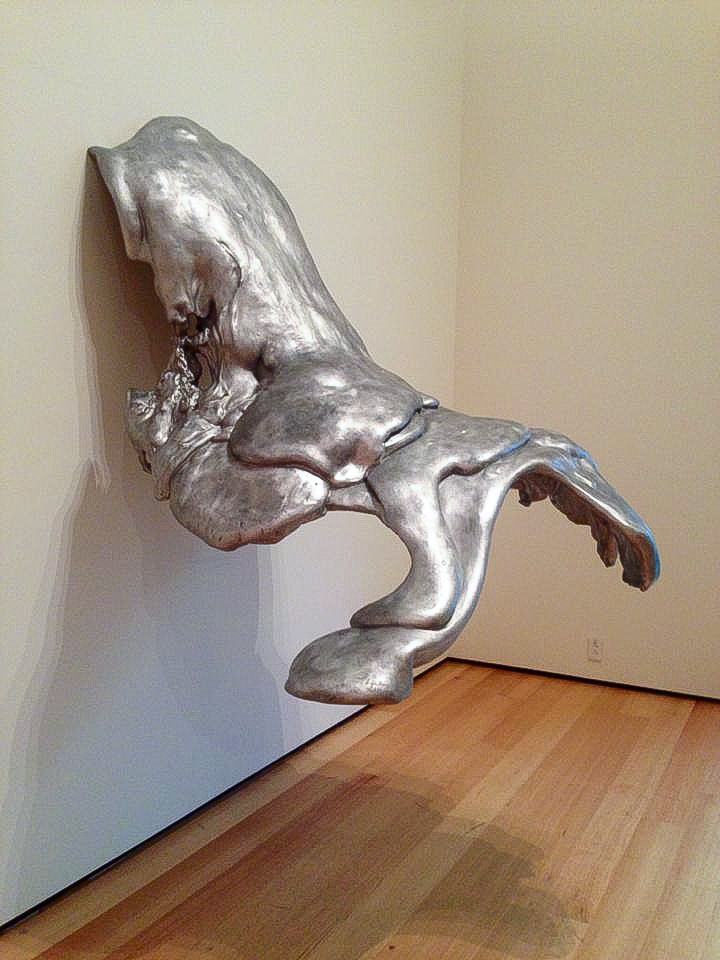
Free flowing visual language defines much of Benglis’s work. She uses materials and suggestiveness to create “frozen gestures.” It is the way I have always considered glaze, an elusive material visually caught between solid and liquid. Her rainbow latex pieces are earlier echoes of what I see going on in a lot of ceramics today. Extending beyond her poured latex work, she made lava-like blobs and waves cast in metal and other materials. Her ceramics in the early 1990s look like nascent versions of some of the messy and irreverent vessel experimentation going on now.
If we took a more exhaustive look into the past, there would be a list of “who-did-it-firsts” that would stretch on for days. No one owns “The Drip,” and no one owns glaze. Drippy and crackled glazes are both really, really old. However, the current binge on special effects glazes is unique and extreme. We are testing the limits of ceramic materiality – coming up with puffy, elastic, foamy, and polychromatic surfaces. It’s not about the “Gloop,” but how you use it and what it means in your work. Many artists have arrived at these techniques with their own stories to tell about how they got there.
Seeing an absence of the feminine legacy in social media debates about the origins of a dominating trend – I felt a new sense of duty. I could no longer keep these pearls to myself. When I resolved to share Masaro’s name on Instagram where I suspected it had never been seen, I was met with the most resounding, “That was made in the 1970s? It feels so fresh!”

